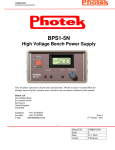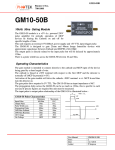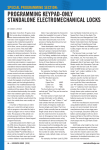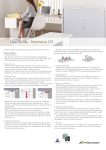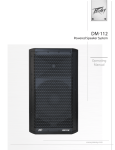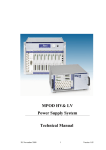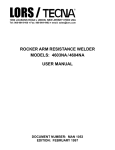Download PDF - Photek Limited
Transcript
UMDPS15N DPS1-5N Digital High Voltage Power Supply This document supersedes all previous specifications. Photek accept no responsibility for damage incurred if the customer does not follow the procedures outlined in this manual. Photek Ltd 26 Castleham Road St Leonards-on-Sea East Sussex United Kingdom TN38 9NS Telephone Facsimile E-mail: +44 1424 850555 +44 1424 850051 [email protected] Issue 1 24th February 2014 1 Manual No Issue: Date: Author: UMDPS15N 1 24-2-2014 P Simpson UMDPS15N Contents 1 DPS1-5N DESCRIPTION 4 2 SAFETY:- 4 3 FRONT PANEL DESCRIPTION 5 3.1 Power Switch 5 3.2 Adjust Control 5 3.3 Touch Control Display 5 4 REAR PANEL DESCRIPTION 7 4.1 IEC Mains Inlet 7 4.2 HT Output Connector 7 4.3 GND Terminal 8 4.4 Interlock & Power Output 8 4.5 RS-232 Connector 9 4.6 DC Power Output Fuses 9 4.7 Interlock Inputs 5 HIGH VOLTAGE CONNECTION NOTES:- 11 6 OPERATING INSTRUCTIONS 12 7 RS-232 SERIAL INTERFACE 14 10 7.1 Serial Link Configuration 7.1.1 Configuration Summary:7.1.2 Command Acknowledgement 14 14 14 7.2 15 DPS1 Serial Commands 2 Manual No Issue: Date: Author: UMDPS15N 1 24-2-2014 P Simpson UMDPS15N 7.3 Command & Data Format 7.3.1 Command List Request 7.3.2 Channel and Voltage Setting 7.3.3 Unit Identification 7.3.4 Get Channel 7.3.5 Set Ramp Rate 7.3.6 Set Interlock/s 7.3.7 Verbose 7.3.8 Power Command 16 16 16 16 17 18 18 19 19 8 SPECIFICATIONS 20 9 ITEMS SUPPLIED 21 3 Manual No Issue: Date: Author: UMDPS15N 1 24-2-2014 P Simpson UMDPS15N 1 DPS1-5N Description The DPS1 is a. mains powered digital high voltage power supply unit with a universal input which will operate between 90-260V a.c.. There is one high voltage output which may be used to power a detector fitted with a potential divider network. This unit contains one negative power supply module with the following specifications:High Voltage Output Maximum -5kV Output Current Maximum Full Load Ripple 500uA 800mV Features of this unit are:• Variable high voltage output with 1V resolution display. • dv/dt voltage adjustment feature to control changes in the output with ‘ramp up’ function to avoid sudden changes in the output voltage. • Output Short Circuit and Flash-over protection. • Two user interlock functions. • Three fused low voltage power outputs (+12V,+5V,-12V) The DPS1 does not provide any image acquisition or image processing functions. 2 Safety:The high voltage module contained within the DPS-1 has a maximum current capability as follows:• V1 (-5kV module) 500uA The maximum output energy that can be delivered by this module is limited to less than 4 joules for user safety, Warning:- If a large capacitive load is connected across the output, the energy stored by this external capacitor may exceed this limit. Energy Stored By Capacitor = ½ CV2 joules In order to avoid any corona discharge: - Under no circumstances should a high voltage output be run at a voltage higher than 5kV in air without some insulation material encapsulating the high voltage connection. 4 Manual No Issue: Date: Author: UMDPS15N 1 24-2-2014 P Simpson UMDPS15N 3 Front Panel Description The front panel of the DPS1 is illustrated below: - 3.1 Power Switch The mains power On/Off switch for the DPS1 unit. 3.2 Adjust Control This is a rotary control which is used to adjust the output voltage of the DPS unit. In order for this control to function the output must be selected by touching the “Set Voltage” area of the touch screen. 3.3 Touch Control Display This is a 3.2” touch control display which allows the control functions of the DPS unit to be accessed manually. The touch sensitive areas are coloured “dark blue” on the display The current operating conditions of the DPS1 are displayed here. Manual modification of functions may be carried out using the touch control interface in conjunction with the Adjust control. Any functions downloaded from the PC will be displayed on the unit status display as soon as they are implemented. 5 Manual No Issue: Date: Author: UMDPS15N 1 24-2-2014 P Simpson UMDPS15N The Touch Screen Display is illustrated below:- The display has 3 active touch sensitive areas: 1. Adjust Voltage Selection Switch: This allows the user to manually select the output and vary the set voltage by use of the Adjust control. 2. High Voltage ON/OFF Switch: This allows the high voltage to be turned on and off. When the high voltage is turned on the output will ramp up over the programmed ramp time, this is to ensure that there is no sudden change in voltage on the device connected to the output. 3. Interlock Function Switch: This allows the user to enable or disable the 2 interlock functions of the DPS1 unit and also displays the status of the interlocks. Each interlock can be either “Disabled”, “Enabled” or “Tripped”.When an interlock is Tripped an audible tone will be emitted from the DPS1 unit and the display will indicate the unsatisfied interlock. There are 3 numerical readings displayed: 1. Set Voltage Display: This displays the output voltage that will be enabled on DPS1 when the output is turned on. The voltage displayed here will be adjusted when the Adjust voltage selection switch has been pressed. The output does not have to be turned on in order to adjust the set voltage. (Display Resolution = 1V.) 2. Actual Voltage Display: This displays the voltage present on the output of the DPS unit. If the output is turned off this will display 0V. When the output is turned on the user will observe the voltage incrementing gradually up to the set voltage. 3. Current Display: The current drawn from the output is displayed here, the current measurement is in micro Amps (uA) with a maximum resolution of 1uA. 6 Manual No Issue: Date: Author: UMDPS15N 1 24-2-2014 P Simpson UMDPS15N 4 Rear Panel Description The rear panel of the DPS1 is illustrated below: - 4.1 IEC Mains Inlet The mains input for this unit is via a fused IEC inlet. This unit accepts any a.c. mains voltage between 90V and 250V, either 50Hz or 60Hz. For voltages below 120Vac a 2.5A fuse should be fitted and for voltages in the range 220V or higher a 1.5A fuse should be fitted. Fuses are 5x20mm (dia. x length). 4.2 HT Output Connector The HT Output high voltage connector fitted to the DPS1 is an SHV BNC socket rated at 12kV d.c. The SHV BNC High Voltage connector pin assignment and voltages supplied are as follows: HT Output Function Output Voltage Center High Voltage Output 0V to -5000V Shield 0V 0V 7 Manual No Issue: Date: Author: UMDPS15N 1 24-2-2014 P Simpson UMDPS15N 4.3 GND Terminal This is an M5 terminal binding post which may be utlised as an easy access 0V/Earth connection for test and measurement or for system earth bonding. Under no circumstances should this be used as a 0V power return connection for the high voltage or the low voltage outputs from this unit. The high voltage return is the screen of the SHV connector and the low voltage 0V return connections are located in the 15-way D Connector. 4.4 Interlock & Power Output This is a 15-Way D-type Socket which provides 3 low voltage power supplies for external peripheral units and the interlock input connections. This may be utilised to provide power for units used in conjunction with the DPS1 unit such as gate units and pre-amplifier modules or interlock interface circuitry. Each power output is available on 2 pins of the connector as detailed in the table below and there are multiple 0V connections available to allow for several units to be powered with individual power and ground connections for each unit. The output pinouts for this connector are detailed below: - (View as seen looking at the rear panel) Pin Number Output Voltage Maximum Current 4 to 6 (Inclusive) 12 to15 (Inclusive) 1&9 0V +12V 1A 2 & 10 +5V 2A 3 & 11 -12V 0.25A 8 Interlock 1 Input 7 Interlock 2 Input 8 Manual No Issue: Date: Author: UMDPS15N 1 24-2-2014 P Simpson UMDPS15N 4.5 RS-232 Connector This is an asynchronous serial communication port operating at a fixed baud rate of 57600. This enables the DPS1 to be controlled from a standard PC by means of ASCII control characters and codes. The DPS1 RS-232 uses a 2 wire system (transmit and receive), handshaking is implemented in software for confirmation of valid control codes. A full listing of codes and protocols are listed in the software interface section of this manual. The RS-232 connector is a 9-Way D-Type Plug. Pin-out functions are listed below: - (View as seen looking at the rear panel) 9 Way D-type plug Pin No. Function Pin 2 Transmit data Pin 3 Receive data Pin 5 Ground/ 0V The DPS1 is supplied with a USB to RS232 converter lead Photek part number ED375. The driver software for this can be found on the CD supplied with the system. 4.6 DC Power Output Fuses These are the three 5x20mm internal fuses for the low voltage power outputs. The output voltage and fuse rating of each output is indicated above the fuse holder and is detailed in the Table in the “Interlock and Power Output” section of this manual. The combined current utilised by peripheral units must not exceed the rated output of the power supply voltage rail being utilised. If the rated power output is exceeded the internal functions of the DPS unit may be compromised, under no circumstances should fuses higher than the rated value be fitted into this unit. 9 Manual No Issue: Date: Author: UMDPS15N 1 24-2-2014 P Simpson UMDPS15N 4.7 Interlock Inputs The DPS1 has 2 interlock inputs which may be used together or individually. When used together the interlocks observe a logical OR function to disable the high voltage output i.e. if either interlock is enabled and not satisfied the high voltage output will be turned off. Each interlock is enabled individually by successive presses of the “Interlocks” area of the touch screen. The interlock setting will cycle through the sequence: Interlocks Disabled, Interlock 1 Enabled, Interlock 2 Enabled, Both Interlock 1 and 2 Enabled and back to Interlocks Disabled again. When an interlock is enabled and not satisfied the DPS unit will disable the high voltage output and emit an audible tone until either all interlocks are satisfied or the unsatisfied interlock is disabled. This audible tone will be emitted even if the high voltage is not enabled. Each interlock input is an active low input which requires a 0V connection to satisfy the internal logic and allow the high voltage to be enabled. An internal pull-up resistor ensures that if the interlock is enabled but the interlock input is open circuit, the interlock will be unsatisfied and the high voltage will be disabled, an audible tone will be emitted to indicate an unsatisfied interlock. The ‘Interlock and Power Output’ 15-way D connector socket is the interlock interface input for the DPS unit. Please Refer to section 4.4 for pinout information. 10 Manual No Issue: Date: Author: UMDPS15N 1 24-2-2014 P Simpson UMDPS15N 5 High Voltage Connection Notes:All High Voltage connections must be made before applying power to this unit. The connector supplied with this unit is an 12kV rated high voltage SHV BNC connector. Care should be taken to ensure that correct connections have been made before power is applied to this unit. For Photek supplied systems all high voltage connectors will be supplied with the system. Any user terminated connections must be carried out with adequate precautions to ensure safety of both user and equipment The following precautions should be observed for connections made by the user: 1. All wires must have an adequate voltage rating for the high voltage that they will carry. 2. All wires utilised in a vacuum chamber must be suitable for this application. 3. All wires should be continuous and connected to the SHV BNC plug at one end and the Channel plate detector or appropriately rated connector at the other end. These wires should not be ‘wired inline’, i.e. joined. 4. Mechanical strength of connections should be ensured with adequate strain relief to ensure reliable operation and extended life of the connections. 5. Connections should be insulated with suitable insulation material, such as heatshrinkable insulation tubing or a suitable silicon compound may be used to encapsulate the connections. 11 Manual No Issue: Date: Author: UMDPS15N 1 24-2-2014 P Simpson UMDPS15N 6 Operating Instructions 1. The DPS1 high voltage output must be connected to the device before application of power to this unit. 2. On power up the HT module will be “OFF”. The required voltage may be set before powering on the HT module. Press the adjust voltage selector switch area to enable the “Adjust” control. When the voltage may be edited the voltage display box will turn yellow as illustrated: - 3. Set the voltage required on the output using the “Adjust” control. At this point the output is still off. 4. Press the “ Output ON/OFF ” area and the output will start ramping up. When the power is on the ‘Actual Voltage’ display text turns red and the “Output ON/OFF” area turns red as illustrated below: - Note : - During the “Ramping Up” phase the text in the Voltage Selector switch area will turn Red, this indicates that the output is not at its setpoint. When the output reaches its setpoint the text changes back to white. 12 Manual No Issue: Date: Author: UMDPS15N 1 24-2-2014 P Simpson UMDPS15N 5. The output may be adjusted dynamically while it is on by pressing the adjust voltage selector switch area to enable the “Adjust” control. When the output is “ON” the current drawn from the ouput will be displayed in the current display area of the display. 6. Interlocks may be enabled or disabled at any time by pressing the Interlock Function switch. If an interlock is enabled and unsatisfied the interlock display area will turn red and the text for the unsatisfied interlock will changed to “Tripped”. An audible tone will be emitted from the DPS unit to alert the user to an interlock problem. The first press of any switch area on the DPS display or a press of the adjust control will accept the interlock and cancel the audible alarm. However the High Voltage will not be allowed to turn “ON” until either the interlock is satisfied or disabled. 13 Manual No Issue: Date: Author: UMDPS15N 1 24-2-2014 P Simpson UMDPS15N 7 RS-232 Serial Interface 7.1 Serial Link Configuration The RS-232 utilised by the DPS1 is a 3-wire interface for asynchronous transmission and reception of data. The interface utilises TD (Transmit Data), RD (Receive Data) and Gnd from the RS-232 protocol. The Baud rate for communication is fixed at 57600; this is programmed into the DPS1 and cannot be modified. The Data format is No Parity, 8 Data bits and 1 stop bit. All data transmitted to or from the DPS1 is in ASCII format. Commands take the form of letters and variables are ASCII numbers. 7.1.1 Configuration Summary:Baud Rate Parity Data Bits Stop Bits = = = = 57600 No 8 1 7.1.2 Command Acknowledgement When a serial command is received it may be acknowledged or the acknowledgement can be supressed if the user wishes by enabling the “vb” or “verbose” command. To suppress command acknowledgement send a “vb1” or “vb0” command and the DPS1 will accept commands but not acknowledge them. To re-enable command acknowledgement send a “vb2” command. The following is a list of command acknowledgements and error codes that may be received by the user. Response ok err 1 command not recognised err 2 parameter missing err 301 number out of range Description Of Response command accepted and executed characters entered are not a valid command valid parameter required command not accepted as the value is out of the range of the function being updated 14 Manual No Issue: Date: Author: UMDPS15N 1 24-2-2014 P Simpson UMDPS15N 7.2 DPS1 Serial Commands The commands for the DPS1 have been enabled in 2 ways, short commands for quick control by the user typing the commands and also as long commands (words) that may be used in software code to make it more readable/understandable. DPS1 user commands are listed below: Short Long Command Command Description cmds commands Command Table Request sc setchannel Channel Selection and Voltage Setting id version Unit Name & Software Version Request sr setramp High Voltage Ramp-Up rate Setting p power High Voltage Power Off, On gc getchannel Channel Selection and Voltage Reading si setinterlock Interlock Setting vb verbose Response Selection Note: - Commands are not case sensitive. 15 Manual No Issue: Date: Author: UMDPS15N 1 24-2-2014 P Simpson UMDPS15N 7.3 Command & Data Format 7.3.1 Command List Request The command list request command allows the user to see a list of all user commands available for the DPS1. The format of this command function is illustrated below: Command Function ASCII Command Letter ASCII Integer Data String Command List Request cmds - Notes (commands) 7.3.2 Channel and Voltage Setting The setchannel command character/s must be followed by 2 ASCII variables, the first is the channel number, for a DPS1 this will always be 1, the second variable is the actual voltage required, for negative power supplies a “-” sign is required for the output voltage to be accepted. The format of this command function is illustrated below: Command Function ASCII Command Letter ASCII Integer Data String Notes Channel Select and Voltage Setting sc 1,-1000 Channel 1 Output set to -1000V (setchannel) 7.3.3 Unit Identification The unit identification may be requested from the DPS1 by using the ‘id’ command. The returned data will be the unit type ‘DPS1’ and the firmware issue number i.e. ‘V1.00’. each data element will be de-limited by a comma, an ok will follow the returned data string. The format of this command function is illustrated below: Command Function ASCII Command Letter ASCII Integer Data String Returned Data Request Unit Identification id - DPS1,v1.00,ok (version) (no data string) 16 Manual No Issue: Date: Author: UMDPS15N 1 24-2-2014 P Simpson UMDPS15N 7.3.4 Get Channel The getchannel command enables the user to request the operating conditions of the DPS1 unit. The getchannel command character/s must be followed by 2 ASCII variables, the first is the channel number, for a DPS1 this will always be 1, the second ASCII variable is the number indicating the variable that is to be requested There are 10 variables that may be requested, these are listed below: 1. Measured Voltage Value. 2. Set Voltage Value. 3. Measured Current Value. 4. Absolute Voltage Limit – High 5. Absolute Voltage Limit – Low 6. Relative Voltage Limit – High 7. Relative Voltage Limit – Low 8. Interlock Enable/Disable Status 9. Interlock Input Actual Status 10. Ramp Speed. Data is returned in floating point notation, OK is returned on receipt of a valid command. The format of this command function is illustrated below: Command Function ASCII Command Letter Valid ASCII Integer Data Data Requested Get Channel Data gc 1,1 Measured Voltage (getchannel) 1,2 Set Voltage 1,3 Measured Current For the interlock status request functions the data returned indicates the following: Data Returned Interlock Enable/Disable Interlock Input Actual Status Status 0 Both Interlocks Disabled Both Interlocks Satisfied 1 Interlock 1 Enabled Interlock 1 Unsatisfied 2 Interlock 2 Enabled Interlock 2 Unsatisfied 3 Both Interlocks Enabled Both Interlocks Unsatisfied 17 Manual No Issue: Date: Author: UMDPS15N 1 24-2-2014 P Simpson UMDPS15N 7.3.5 Set Ramp Rate The speed that the high voltage rises from 0V to its set value is controlled by the “SetRamp” command. This is a command followed by an ASCII number variable which is equivalent to seconds equal or greater than 1. (i.e. minimum ramp rate = 1 second) The format of this command function is illustrated below: Command Function ASCII Command Letter ASCII Integer Data String Equivalent Ramp Speed Set Ramp Rate sr 10 10 seconds (setramp) 3600 1 hour 7.3.6 Set Interlock/s The set interlocks command allows the required interlocks to be enabled/disabled. The setinterlock command character/s must be followed by one ASCII variable, this is the setting required for the interlocks. The interlocks are function variable is illustrated by the following table: Data Sent Interlock Enable/Disable Status 0 Both Interlocks Disabled 1 Interlock 1 Enabled 2 Interlock 2 Enabled 3 Both Interlocks Enabled The format of this command function is illustrated below: Command Function ASCII Command Letter ASCII Integer Data String Notes Set interlocks Si 0 Both interlocks Disabled 1 Interlock 1 Enabled 2 Interlock 2 Enabled 3 Both interlocks Enabled (setinterlock) Set interlocks Si (setinterlock) Set interlocks Si (setinterlock) Set interlocks Si (setinterlock) 18 Manual No Issue: Date: Author: UMDPS15N 1 24-2-2014 P Simpson UMDPS15N 7.3.7 Verbose The verbose command allows the user to specify the level of command acknowledgement required from the DPS1 unit. The “vb” command is followed by either a 0, 1 or 2. 0 indicates no repsonses required, 1 enables just error responses, 2 enables all responses. The default state for verbose is all acknowledgements are enabled. The format of this command function is illustrated below: Command Function ASCII Command Letter ASCII Integer Data String Notes Set Command Acknowledgement vb 0 No Acknoledgements 1 Only Errors are Acknowledged 2 Enables all acknowledgements (verbose) 7.3.8 Power Command The power command provides an on/off function for the High Voltage PSU. The format of this command function is illustrated below: Command Function ASCII Command Letter Maximum/ Minimum ASCII Integer Data String Command String Transmitted Instruction Equivalence High Voltage Power On/Off p 1 p1 HV Power On (power) 0 p0 HV Power Off 19 Manual No Issue: Date: Author: UMDPS15N 1 24-2-2014 P Simpson UMDPS15N 8 Specifications Mechanical: DPS1 Size: depth 290mm (Maximum Extents) width 155mm height 100mm DPS1 Weight: ≈2.2Kg Panel Colour: Umbra Grey (RAL7022) Case Colour: Pebble Grey (RAL7032) Bezel Colour: Stone Grey (RAL7030) Electrical: Supply Voltage : Universal 90-260V 50/60Hz FuseRating Required: 100V/110V/120V 2.5Amp 220V/230V/240V 1.5Amp HT Output Voltage 0V to –5kV HT Output Current Maximum 500uA Maximum Ripple on Full Load 800mV 20 Manual No Issue: Date: Author: UMDPS15N 1 24-2-2014 P Simpson UMDPS15N 9 Items Supplied The following Items are deliverable with the DPS1-5N system:Item No. Description Quantity 1 DPS1-5N Power Supply 1 2 ED573 - 2m SHV to SHV BNC Cable 1 3 ED375 - 2m USB to RS232 Lead – USB A to 9-Way D type Socket 1 4 2m IEC Mains Lead with a moulded plug (US, UK or European Plug) 1 5 DPS1 CD - USB Driver and Manual 1 6 DPS1-5N User Manual 1 © Photek Ltd. February 2014 Any unauthorised adjustment or modification to this unit will void all warrantees and will only be supported at Photeks discretion. Photek reserves the right to ammend general information contained in this manual without prior notice. 21 Manual No Issue: Date: Author: UMDPS15N 1 24-2-2014 P Simpson





















